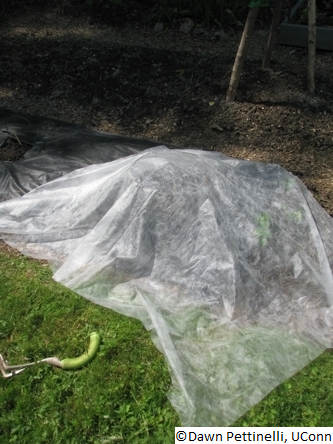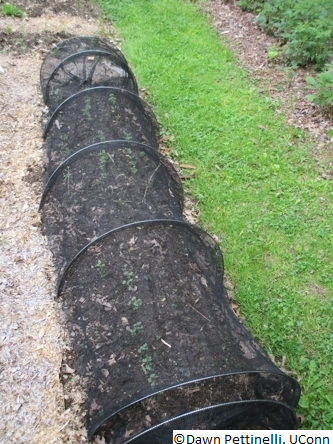Extending the Season in the Garden
Extending the gardening season as late into the fall as possible is an enticing idea to most gardeners of the Northeast. Tomatoes, peppers, summer squash and cucumbers do not grow or produce well once air temperatures drop down into the high thirties F. If these warm season crops are touched by an early morning frost they will be severely injured or killed. The garden, however, does not have to completely shut down with the occurrence of a killing frost. There are ways to keep the harvest going, both by the selection of cold-tolerant vegetables and by protecting the crops by the use of different types of covers. Covers can be made of fabrics, plastic sheeting or glass. All of the coverings are based on the idea that radiant heat from the sun will be trapped during the day and released at night when the temperatures drop.
Light may also be a limiting factor. The shorter fall days do not provide enough sunlight to support the amount of photosynthesis necessary to produce a fruiting crop at this time of year. Many root and leaf crops that are planted or growing during the latter part of the summer can be successfully left in the ground and if protected, they can be harvested throughout the fall and into the winter. The plants will continue to grow, weather permitting, but just at a much slower rate.
Row Covers
Several degrees of protection can be had from a floating row cover. This is a light weight, spun-bonded polyester fabric commonly called by its trade name, Reemay®. Other companies make similar products and all work in the same manner. The fabric is permeable and lets air and water pass through while simultaneously acting like a blanket holding in about five degrees of heat when laid over the crops and anchored in place. Just that five degrees can keep tender crops from being damaged by light frosts. These fabrics are available in a variety of thicknesses providing protection from temperatures as low as 25º F for some crops. As the weather gets colder, the row covers can be topped with a layer of floating plastic sheeting for even more protection. Both floating row covers can be help in place with U-shaped pins, sand bags or rocks. The plastic sheeting should not touch the plants directly.

Hoop or Low Tunnels
Hoop or low tunnels are one step up from free floating row covers. Hoops can be bent and placed in the soil over the crop to hold up the row covers or plastic sheeting about 2-3' above the plants. The hoops keep the fabric or plastic from coming in contact with the plants which prevents cold air from being transferred through the plastic onto any leaves it touches. Attention should be paid to heat buildup during sunny days as temperatures can rise to harmful levels. Damage can be avoided by pulling back the plastic or lifting the sides on bright days. Some types of plastic sheeting designed to cover crops are self-venting. They have slits in the top which will open as the air warms and expands. When the air cools, the pressure inside the low tunnel decreases and slits close.

High Tunnels
High tunnels are taller and more elaborate plastic covered structures that one can walk into. Basically they are an unheated greenhouse. Doors and vents are needed for access and airflow. Plants are still grown directly in the soil, either in rows or beds, with the protective structure surrounding the crops. The sides of the plastic sheeting should be engineered with the ability for them to be rolled up for added ventilation. Fans are installed inside to move air and reduce heat buildup from bright sun. Irrigation will be needed as rainfall will not be landing on the soil inside the high tunnel. The frameworks for high tunnels are larger diameter pipes with more structural integrity to withstand snow and water loads.
Cloches
Cloches are bell shaped covers made of glass or clear plastic and would be placed over individual plants. They warm the soil and keep frost off of the plant. Heat can build up very quickly when using cloches. Glass cloches can be heavy and are fragile so they need to be handled with care. It is believed they were created by the French in the 1600’s or so and were found in early American Colonial gardens as well.
Cold Frames
Cold frames are traditional structures made of wood sides with a hinged glass or plexiglass cover. The wood portion is a about a foot high and can to be the same dimension as the clear cover. The wood framed bottom should be oriented to be facing south with the most southerly facing side a few inches shorter to obtain the most sun with less shadows.
Cold frames do not have added heat, only protection from wind and cold. They gather the sun’s heat during the day, and closed at night to keep the heat in. Again, attention must be paid to how much the temperature is rising inside the cold frame during the day. The hinged cover should be propped open on sunny days. Ready-made cold frames often come with automatic openers that lift up the covers as the temperatures rise.
All these methods of climate modification are most useful at prolonging the harvest of vegetable crops that prefer and tolerate lower light levels and colder temperatures. Many seed companies list these attributes in the catalogs and packages.
Vegetable Selection
Leafy crops and root crops tolerate cold much better that fruiting plants. The flavor of some vegetables improves, often becoming sweeter or milder after exposure to cold. Selecting specific varieties which are bred for their cold tolerance will also give longer lasting harvests. Typically, the crops that have good cold tolerance are those that are planted in early spring. These are the same crops that will also do well towards the end of the growing season.
Spinach will produce leaves late into the fall under cover, and then when the freezing temperatures hit, it will hunker down waiting for the first warm weather of early March to continue growing. The roots and crown of the plant will have been protected in the soil even if the top leaves look horrid. New leaf growth will renew your faith in the seasons while supplying a fresh salad for your table in late winter or early spring. The varieties ‘Space’, ‘Winter Bloomsdale’ and ‘Giant Winter’ have exhibited exceptional hardiness.
Lettuce will produce cutting leaves if non-heading varieties are selected. These will not survive severely hard freezes, but leaves can be cut from the sides, leaving the crown of the plants well into December. More cold tolerant varieties are listed as ‘Red Oak Leaf’, ‘Winter Density’, and ‘Rouge d’Hiver’. Some seed companies sell winter leaf lettuce mixed seed packets containing only cold tolerant varieties of lettuce.
Arugula is a spicy leaf used alone in a salad or mixed in with other greens. It has great cold tolerance. Varieties commonly available are ‘Astro’ and ‘Sylvetta’. Arugula tends to bolt in the heat of summer, preferring to grow in the colder weather.
Totsoi is an Asian green that can be cooked or eaten raw. There are many different Asian greens in the bokchoi group that all have superior cold hardiness. Some varieties are ‘Mei Qing Choi’ and ‘Tokyo Bekana’. This group includes the tart mustards that are commonly steamed or used in salads.
Swiss chard is a leaf crop in the same family as spinach and beet. It is treated much the same as spinach, going dormant during the coldest periods and producing a resurgence of growth in the first warm days of late winter. Pick the leaves and leave the growing crown. ‘Bright Lights’ is a good variety with cold tolerance.
Kale is a favorite cold weather green. With variety names like ‘Winterbor’ and ‘True Siberian’ their cold hardiness speaks for itself. Kale can be harvested through the winter by just knocking the snow off of and cutting the leaves off of the stem. Some will keep producing leaves all winter long.
Parsley is one herb that will take the cold. It can be grown in the same way as these other greens, with a bit of winter protection. There are flat leaf and curly varieties, but the curly types are more cold tolerant. ‘Forest Green’ is a common variety planted to winter over.
Root crops planted in mid to late summer will produce most of their root growth before going into the cold temperatures and less light time. Roots can be given protection to be harvested throughout the fall and winter from their tucked in beds. Potatoes are the exception. They are tuber, not a root.
Carrots become sweeter when keep in the soil during cold weather. ‘Napoli’ is a good winter carrot as is ‘Autumn King’. White and yellow turnips are wonderful for extended season gardens. Like carrots, they develop much more sweetness after experiencing some cold. ‘Hakurei’, ‘Orange Jelly’ and ‘Amber Gold’ are great keepers. Radish is a quick growing crop that can be planted through October and still produce viable roots for eating. Just about any radish variety will be successful for later harvesting.
Leeks are a commonly kept over the winter, sometimes with no more protection than a layer of straw placed over them. In order to have winter leeks, seeds need to be started indoors in late winter to early spring and the transplants set out usually in late April or May. Leeks take a long time to produce large, white stems of substantial diameter often 100 days or more. ‘Saint Victor’, ‘Alaska’ and ‘Broad London’ are known for their ability to hold in cold weather.
For that extended harvest, select some appealing vegetable varieties and figure out what system would work best in your yard. Often the harvest season can be lengthened by a month or more. Most systems do not require a heavy investment of money or equipment just a bit of ingenuity and a desire to extend the harvest.
For pesticide information or other questions please call toll free: 877-486-6271.
Revised by the UConn Home & Garden Education Center, 2016.
Issued in furtherance of Cooperative Extension work, Acts of May 8 and June 30, 1914, in cooperation with the U.S. Department of Agriculture, the Dean of the College, Cooperative Extension System, University of Connecticut, Storrs. The Connecticut Cooperative Extension System is an equal opportunity employer and program provider. To file a complaint of discrimination, write USDA, Director, Office of Civil Rights, Room 326-W, Whitten Building, Stop Code 9410, 1400 Independence Avenue, SW, Washington, DC 20250-9410 or call (202) 720-5964.